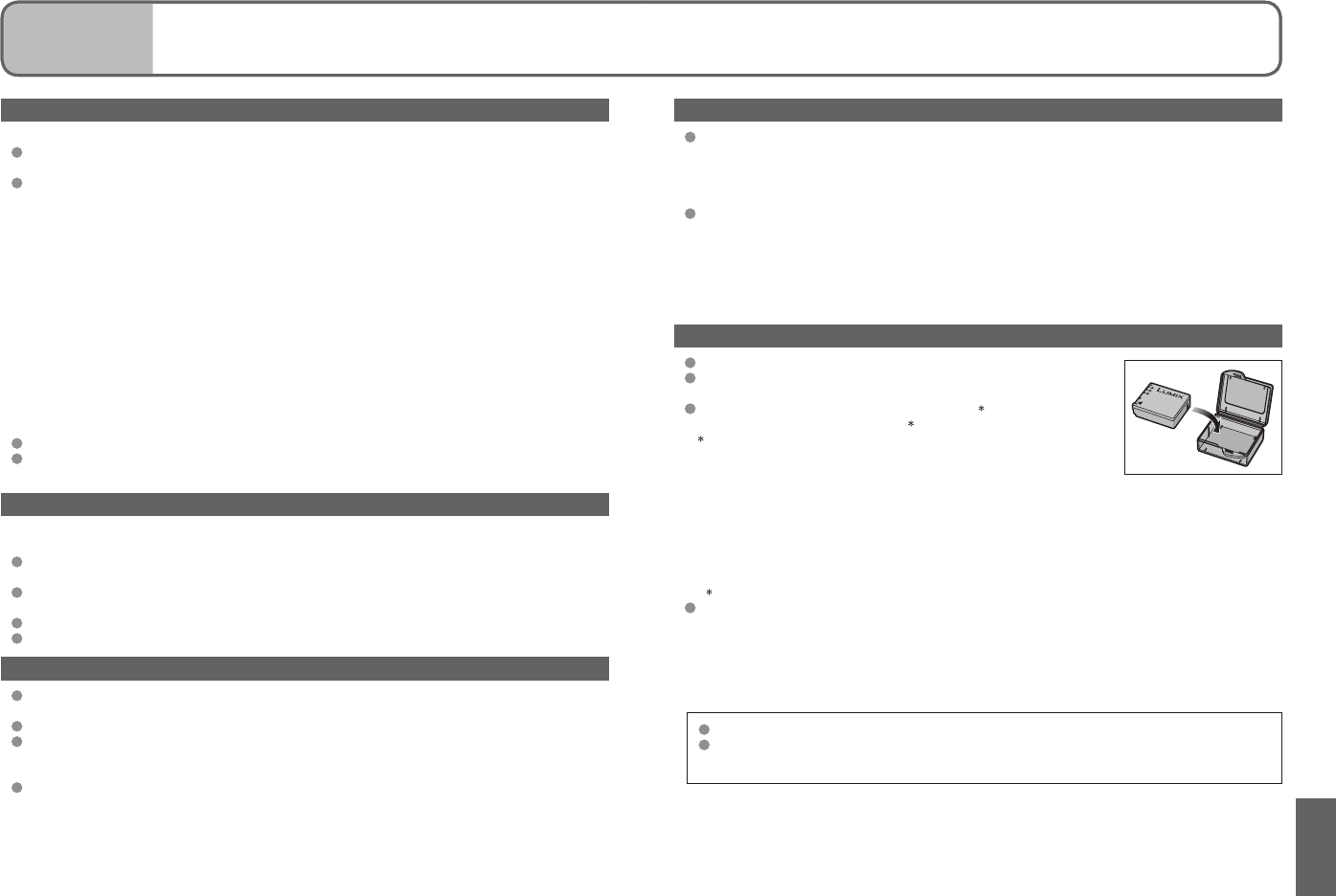
98 VQT1P98 VQT1P98 99
When in use
Camera may become warm if used for long periods of time, but this is not a fault.
To avoid jitter, use a tripod and place in a stable location.
(Especially when using telescopic zoom, lower shutter speeds, or self-timer)
Keep the camera as far away as possible from electromagnetic equipment (such
as microwave ovens, TVs, video games etc.).
• If you use the camera on top of or near a TV, the pictures and sound on the camera
may be disrupted by electromagnetic wave radiation.
• Do not use the camera near cell phones because doing so may result in noise
adversely affecting the pictures and sound.
• Recorded data may be damaged, or pictures may be distorted, by strong magnetic
fields created by speakers or large motors.
• Electromagnetic wave radiation generated by microprocessors may adversely affect
the camera, disturbing the pictures and sound.
• If the camera is adversely affected by electromagnetic equipment and stops
functioning properly, turn the camera off and remove the battery or disconnect AC
adaptor (DMW-AC5G: optional). Then reinsert the battery or reconnect AC adaptor
and turn the camera on.
Do not use the camera near radio transmitters or high-voltage lines.
• If you record near radio transmitters or high-voltage lines, the recorded pictures and
sound may be adversely affected.
Do not extend the supplied cord or cable.
Do not allow camera to come into contact with pesticides or volatile substances (can
cause surface damage or coating to peel).
Caring for your camera
To clean your camera, remove the battery or disconnect AC cable, and wipe with a soft,
dry cloth.
Use a well-wrung wet cloth to remove stubborn stains, before wiping again with a dry
cloth.
Do not use benzene, thinners, alcohol, or kitchen detergent, as these may damage
the outer casing and finish of the camera.
If using a chemically-treated cloth, read the supplied instructions carefully.
Do not touch the lens barrier (P.13).
When not using for a while
Turn off camera power before removing battery and card (ensure that battery is
removed to prevent damage through over-discharge).
Do not leave in contact with rubber or plastic bags.
Store together with a drying agent (silica gel) if leaving in drawer, etc. Store batteries
in cool (15 °C-25 °C) places with low humidity (40% - 60%) and no major temperature
changes.
Charge battery once per year and use completely before storing again.
Memory cards
To prevent damage to cards and data
• Avoid high temperatures, direct sunlight, electromagnetic waves, and static
electricity.
• Do not bend, drop, or expose to strong impacts.
• Do not touch connectors on reverse of card or allow them to become dirty or wet.
When disposing of/transferring memory cards
• If using the ‘format’ or ‘delete’ functions on your camera or computer, this only
changes the file management information, and does not completely delete the data
from within the memory card. When disposing of or transferring your memory cards,
we recommend physically destroying the memory card itself, or using commercially
available computer data erasing software to completely delete the data from the
card. Data within memory cards should be managed responsibly.
Battery and Charger
Store battery in battery carrying case after use.
Do not use if damaged or dented (especially connectors),
e.g. by dropping (can cause faults).
Estimated recording capacity of 300 [330
1
] pictures (P.16)
is based on the following CIPA
2
standards.
1
DMC-TZ11
CIPA standards:
• Using Panasonic SD memory card (16 MB) • Using the
supplied battery • Temperature 23 °C, humidity 50 % • NORMAL PICTURE mode •
LCD monitor ON (The number of recordable pictures decreases in AUTO POWER
LCD, POWER LCD, and HIGH ANGLE mode) • STABILIZER (MODE1) • First picture
taken 30 sec. after power turned on • 1 picture taken per 30 sec. • Full flash used for
every other picture • Zoom operation for each picture (max. W → max. T, or max. T
→ max. W) • Power turned off after each 10 pictures, battery allowed to cool
2
CIPA = Camera & Imaging Products Association
When charging
• Remove any dirt on connectors of charger and battery with dry cloth.
• Keep at least 1 m away from AM radio (may cause radio interference).
• Noises may be emitted from inside of charger, but this is not a fault.
• Always remove from mains socket after charging (up to 0.1 W consumed if left in
place).
SDHC Logo is a trademark.
Other names, company names, and product names printed in these instructions
are trademarks or registered trademarks of the companies concerned.
Others
4
Usage cautions and notes


















